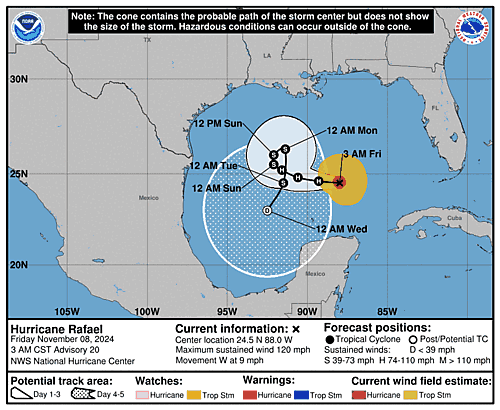Issued at 900 PM CST Thu Nov 07 2024
000 WTNT43 KNHC 080253 TCDAT3 Hurricane Rafael Discussion Number 18 NWS National Hurricane Center Miami FL AL182024 900 PM CST Thu Nov 07 2024 Satellite imagery this evening shows that Rafael has become better organized, with the eye becoming more distinct and the cloud tops in the eyewall getting colder. However, reports from an Air Force Reserve Hurricane Hunter aircraft indicate that this has not yet resulted in strengthening. The central pressure is near 965 mb, and a combination of 700-mb flight level winds and dropsonde data supports an initial intensity of 90 kt. Interestingly, this is at the lower end of the various subjective and objective satellite intensity estimates. The initial motion is now 280/8 kt, and a general westward to west-northwestward motion is expected during the next 48 h or so as Rafael is steered by a building ridge to its north. After that, the track guidance is still quite divergent. The Canadian, NAVGEM, and COAMPS-TC models call for the cyclone to turn northward or northeastward toward the northern Gulf coast as it gets affected by the large deep-layer trough over the southwestern United States. The GFS, which previously supported this scenario, is now calling for a slow anticyclonic loop over the central Gulf of Mexico, and this is also the forecast of the GFS and UKMET ensemble means. The ECMWF, deterministic UKMET, and the GFS-based regional hurricane models still show a turn toward the southwest and south as a narrow ridge builds between the hurricane and the aforementioned trough. To add to the uncertainty, the GFS and ECWMF ensembles still have numerous tracks supporting both the northward and southward turns. Based on the continued guidance spread and continuity from the previous forecast, the new track forecast continues to lean toward the southward scenario, although the new track is a little slower than the previous track to match the overall slower set of guidance. Rafael is currently in an area of light vertical wind shear, and the hurricane is crossing a warm eddy in the Loop Current. This combination should at least maintain the current intensity for the next 12-24 h, and slight strengthening cannot be ruled out. After that, westerly shear is forecast to increase, and while the shear is not likely to be strong it should help advect very dry air into the circulation. This should cause Rafael to steadily weaken, and the intensity forecast has been adjusted to show an increased weakening rate between 24-60 h to better fit the trend of the guidance. The intensity forecast generally follows the faster weakening rate of the global and GFS-based regional hurricane models, as the statistical-dynamical models have a slower rate of weakening. It should be noted that if Rafael turns northward, it would move over cooler sea surface temperatures and encounter stronger shear, which would likely cause a faster weakening than currently forecast. Key Messages: 1. Swells generated by Rafael are likely to cause life-threatening surf and rip current conditions along the Gulf Coast for the next few days. 2. Rafael is forecast to move slowly over the central Gulf of Mexico this weekend and early next week. Interests in the southern and southwestern Gulf of Mexico should monitor the progress of this system. FORECAST POSITIONS AND MAX WINDS INIT 08/0300Z 24.6N 87.1W 90 KT 105 MPH 12H 08/1200Z 24.7N 88.4W 90 KT 105 MPH 24H 09/0000Z 24.8N 89.9W 85 KT 100 MPH 36H 09/1200Z 25.1N 91.1W 70 KT 80 MPH 48H 10/0000Z 25.2N 91.9W 60 KT 70 MPH 60H 10/1200Z 25.3N 92.4W 50 KT 60 MPH 72H 11/0000Z 24.9N 92.7W 45 KT 50 MPH 96H 12/0000Z 23.7N 93.1W 35 KT 40 MPH 120H 13/0000Z 22.0N 93.9W 30 KT 35 MPH $$ Forecaster Beven

